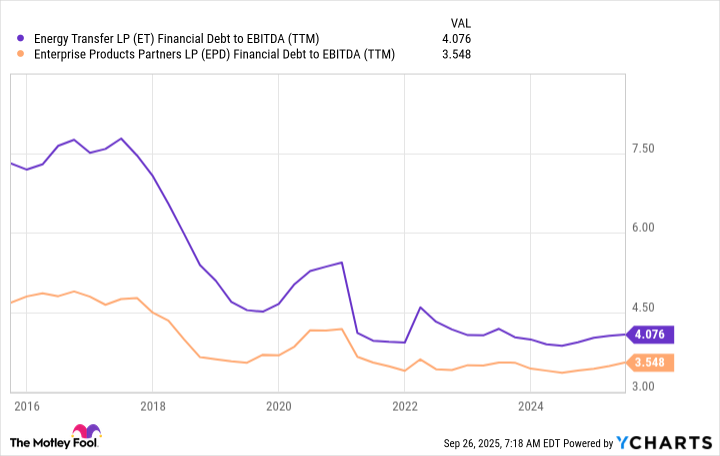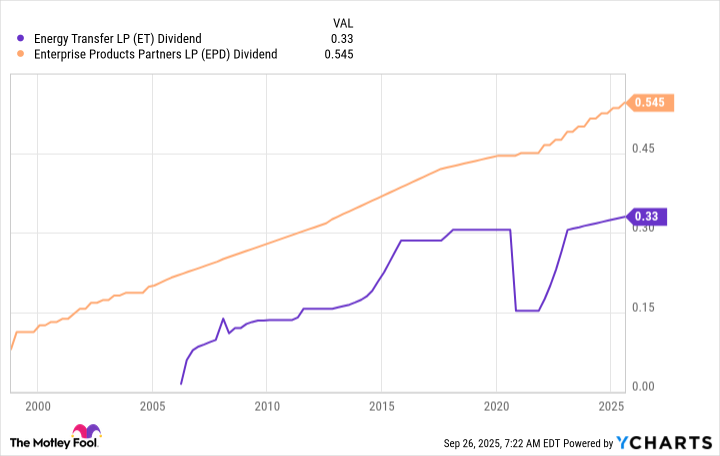The midstream niche of the broader energy sector is replete with high-yield investment opportunities. One that has been getting a lot of attention lately is Energy Transfer (ET +2.29%), which has seen its stock price drop over 15% and its yield rise to more than 7.5%. For context, the S&P 500 index has a yield of 1.2%, and the average energy stock's yield is roughly 3.2%.
Before you buy Energy Transfer, channel famed investor Benjamin Graham and compare it to one of its closest rivals. You might find you prefer the alternative, which has only dipped around half as much and has a slightly lower 6.9% yield.
Who is Benjamin Graham, and what does he have to do with Energy Transfer?
Benjamin Graham was a famed value investor, the author of The Intelligent Investor, and he was one of the main mentors to Warren Buffett. He's widely credited as one of the founding fathers of fundamental analysis. Energy Transfer didn't exist when Graham was alive, so there's really no direct connection here. But one of Graham's favorite tools, used throughout The Intelligent Investor, is highly relevant.

Image source: Getty Images.
Simply put, if Graham were looking at Energy Transfer today, he would likely compare the midstream master limited partnership (MLP) to an alternative investment choice. That's not rocket science, but it is an often-overlooked step on Wall Street. The comparison here is going to be to fellow North American midstream giant Enterprise Products Partners (EPD +1.57%), and it might change your mind on Energy Transfer.
The businesses are roughly similar
From a top-level view, both Energy Transfer and Enterprise operate large, fee-based midstream businesses. Each company's revenue tends to be fairly consistent over time since the main determinant is the amount of oil and natural gas moving through their networks of pipeline, storage, processing, and transportation assets.
Energy demand tends to remain strong even when energy prices are weak, given the importance of oil and natural gas to the world. Energy Transfer is a bit more complex, noting that it is the general partner for two other publicly traded MLPs, but overall, the businesses are roughly similar.

NYSE: ET
Key Data Points
The yields are only a little different
As already noted, Energy Transfer's unit price has dropped around 15% while Enterprise's drop is about half that amount. It isn't surprising that Energy Transfer's yield is higher, at 7.5%. That's around 0.6 percentage points more than Enterprise's 6.9% yield.
Energy Transfer is, essentially, offering dividend investors a nearly 9% boost to the income they would generate from the same dollar value investment. The question that has to be asked here is whether that extra yield is an opportunity or the associated risks are too high, ultimately making the lower yield more attractive.
The yields are both well covered
A key metric to examine for midstream MLPs is distribution coverage. This is basically dividing a business's distributable cash flow by the cash it is actually distributing. The higher the coverage ratio, the better. In this case, both Energy Transfer and Enterprise have strong coverage. That said, Energy Transfer's coverage ratio was 1.7 in the second quarter, while Enterprise's was 1.6. That's a slight edge for Energy Transfer but not a huge one.

NYSE: EPD
Key Data Points
Financial strength is roughly similar
Another important metric in the midstream space is financial debt to EBITDA (earnings before interest, taxes, depreciation, and amortization), which is a measure of a business's leverage. On this measure, Enterprise comes out on top but only by a little. Energy Transfer has a history of operating with more leverage, but it made the decision to deleverage in 2020 (more on this below). At this point, its financial debt-to-EBITDA ratio is around 4 compared to 3.5 for Enterprise.
ET Financial Debt to EBITDA (TTM) data by YCharts. EBITDA = earnings before interest, taxes, depreciation, and amortization. TTM = trailing 12 months.
Energy Transfer's distribution history falls short
Energy Transfer's 2020 decision to reduce leverage, however, came at a material cost. The board of directors enacted a 50% distribution cut. The freed-up cash went toward reducing leverage. Interestingly, Enterprise made a roughly similar choice a few years prior, with the goal of improving its distribution coverage. Only it didn't resort to a distribution cut to improve its financial metrics. It simply slowed down distribution growth for a few years. At this point, Enterprise Products Partners has increased its distribution annually for 27 consecutive years.
ET Dividend data by YCharts.
While Energy Transfer's distribution is growing again, and above where it was prior to the cut, the graph above highlights a big difference. Enterprise Products Partners' distribution has provided a reliable and growing income stream for unitholders. Energy Transfer's distribution has been a lot more variable. This is the big win for Enterprise and the one that will likely make it the better option for most income investors.
The added yield isn't worth the added uncertainty
Energy Transfer and Enterprise Products Partners are so similar that you could persuasively argue for either one as an investment. And neither one is likely to be some huge investment mistake. But if you need the income your portfolio generates to pay the bills, then Enterprise Product Partners' slightly lower yield backed by the more reliable distribution history is probably the best choice. And while the 8% price dip isn't huge, it could still be an excellent opportunity for conservative income investors.

